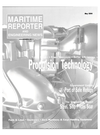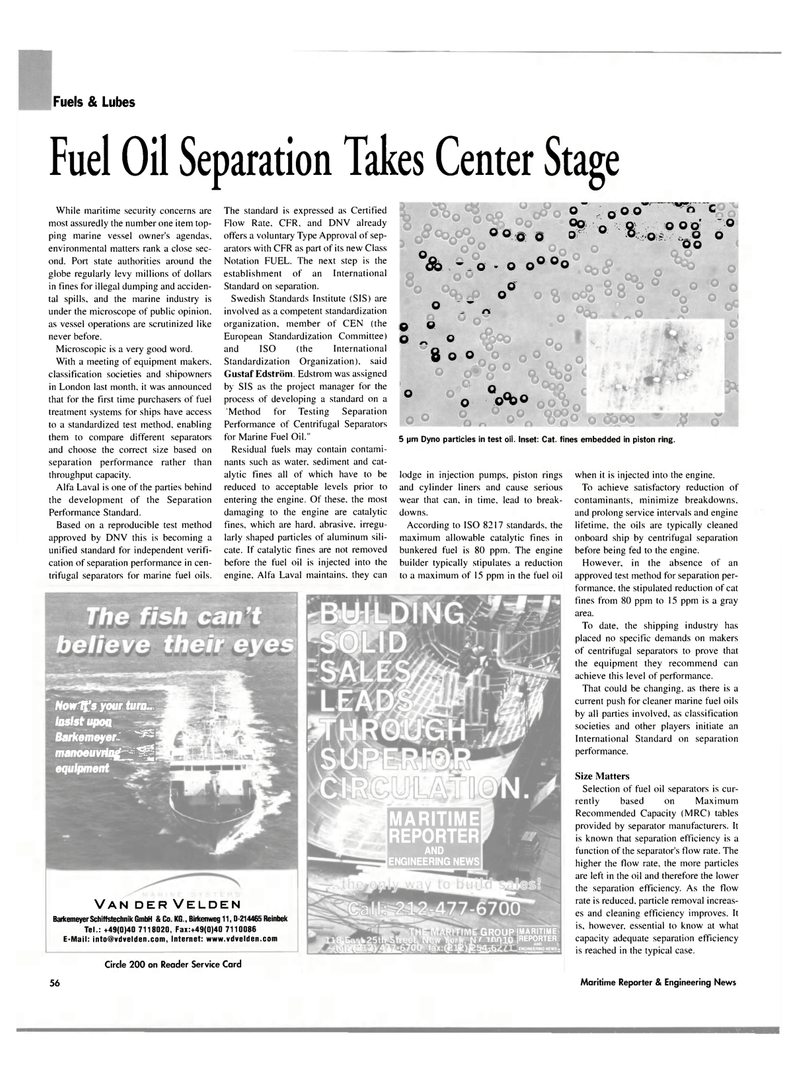
Page 60: of Maritime Reporter Magazine (May 2004)
The Propulsion Technology Yearbook
Read this page in Pdf, Flash or Html5 edition of May 2004 Maritime Reporter Magazine
Fuels & Lubes
Fuel Oil Separation Takes Center Stage 00 Q Q °&> o o° °o ol 0 „
O 0 o" Q o o" c 00 o o 000 0 0 W o o 00 00 0^0
Boo o O °o°bo 5 pm Dyno particles in test oil. Inset: Cat. fines embedded in piston ring.
While maritime security concerns are most assuredly the number one item top- ping marine vessel owner's agendas, environmental matters rank a close sec- ond. Port state authorities around the globe regularly levy millions of dollars in fines for illegal dumping and acciden- tal spills, and the marine industry is under the microscope of public opinion, as vessel operations are scrutinized like never before.
Microscopic is a very good word.
With a meeting of equipment makers, classification societies and shipowners in London last month, it was announced that for the first time purchasers of fuel treatment systems for ships have access to a standardized test method, enabling them to compare different separators and choose the correct size based on separation performance rather than throughput capacity.
Alfa Laval is one of the parties behind the development of the Separation
Performance Standard.
Based on a reproducible test method approved by DNV this is becoming a unified standard for independent verifi- cation of separation performance in cen- trifugal separators for marine fuel oils.
The standard is expressed as Certified
Flow Rate, CFR, and DNV already offers a voluntary Type Approval of sep- arators with CFR as part of its new Class
Notation FUEL. The next step is the establishment of an International
Standard on separation.
Swedish Standards Institute (SIS) are involved as a competent standardization organization, member of CEN (the
European Standardization Committee) and ISO (the International
Standardization Organization), said
Gustaf Edstriim. Edstrom was assigned by SIS as the project manager for the process of developing a standard on a "Method for Testing Separation
Performance of Centrifugal Separators for Marine Fuel Oil."
Residual fuels may contain contami- nants such as water, sediment and cat- alytic fines all of which have to be reduced to acceptable levels prior to entering the engine. Of these, the most damaging to the engine are catalytic fines, which are hard, abrasive, irregu- larly shaped particles of aluminum sili- cate. If catalytic fines are not removed before the fuel oil is injected into the engine, Alfa Laval maintains, they can lodge in injection pumps, piston rings and cylinder liners and cause serious wear that can, in time, lead to break- downs.
According to ISO 8217 standards, the maximum allowable catalytic fines in bunkered fuel is 80 ppm. The engine builder typically stipulates a reduction to a maximum of 15 ppm in the fuel oil when it is injected into the engine.
To achieve satisfactory reduction of contaminants, minimize breakdowns, and prolong service intervals and engine lifetime, the oils are typically cleaned onboard ship by centrifugal separation before being fed to the engine.
However, in the absence of an approved test method for separation per- formance, the stipulated reduction of cat fines from 80 ppm to 15 ppm is a gray area.
To date, the shipping industry has placed no specific demands on makers of centrifugal separators to prove that the equipment they recommend can achieve this level of performance.
That could be changing, as there is a current push for cleaner marine fuel oils by all parties involved, as classification societies and other players initiate an
International Standard on separation performance.
Size Matters
Selection of fuel oil separators is cur- rently based on Maximum
Recommended Capacity (MRC) tables provided by separator manufacturers. It is known that separation efficiency is a function of the separator's flow rate. The higher the flow rate, the more particles are left in the oil and therefore the lower the separation efficiency. As the flow rate is reduced, particle removal increas- es and cleaning efficiency improves. It is, however, essential to know at what capacity adequate separation efficiency is reached in the typical case.
Nowlgsyour turn..,
Insist upon
Barkemeyer ^ manoeuvring^^ equipment
VAN DER VELDEN
Barkemeyer Schiffstechnik GmbH & Co. KG., Biikenweg 11, D-214465 Reinbek
Tel.: +49(0)40 7118020, Fax:+49(0)40 7110086
E-Mail: [email protected], Internet: www.vdvelden.com
Circle 200 on Reader Service Card
MARITIME
REPORTER
AND
ENGINEERING NEWS
GROUP MARITIME
U0QT0 REPORTER engineering "£ws 56 Maritime Reporter & Engineering News

 59
59

 61
61
